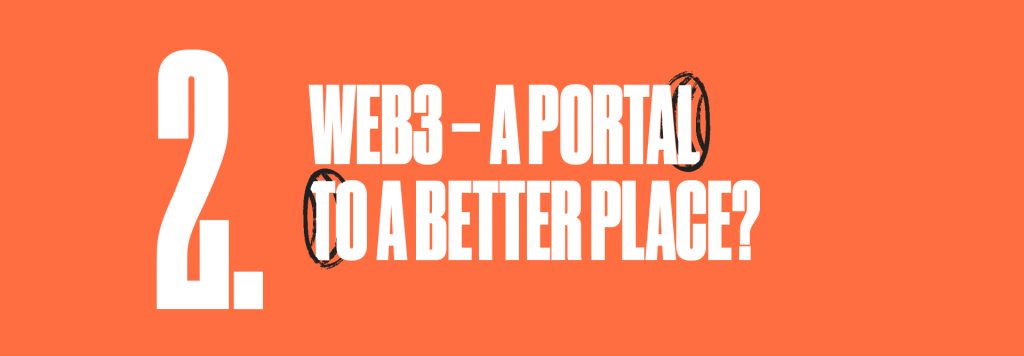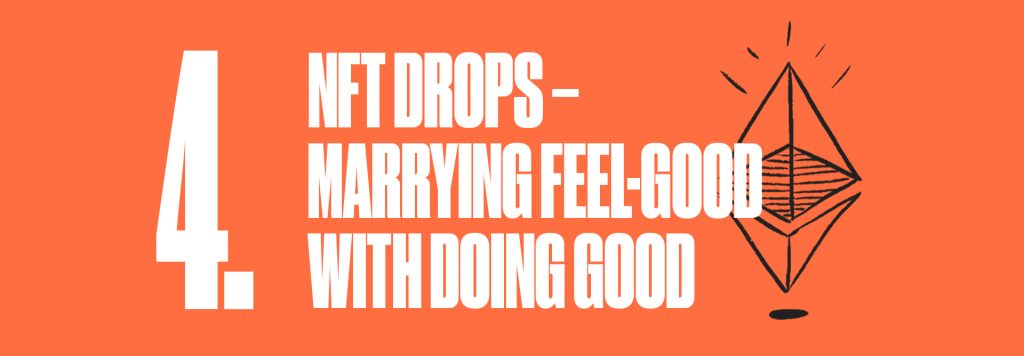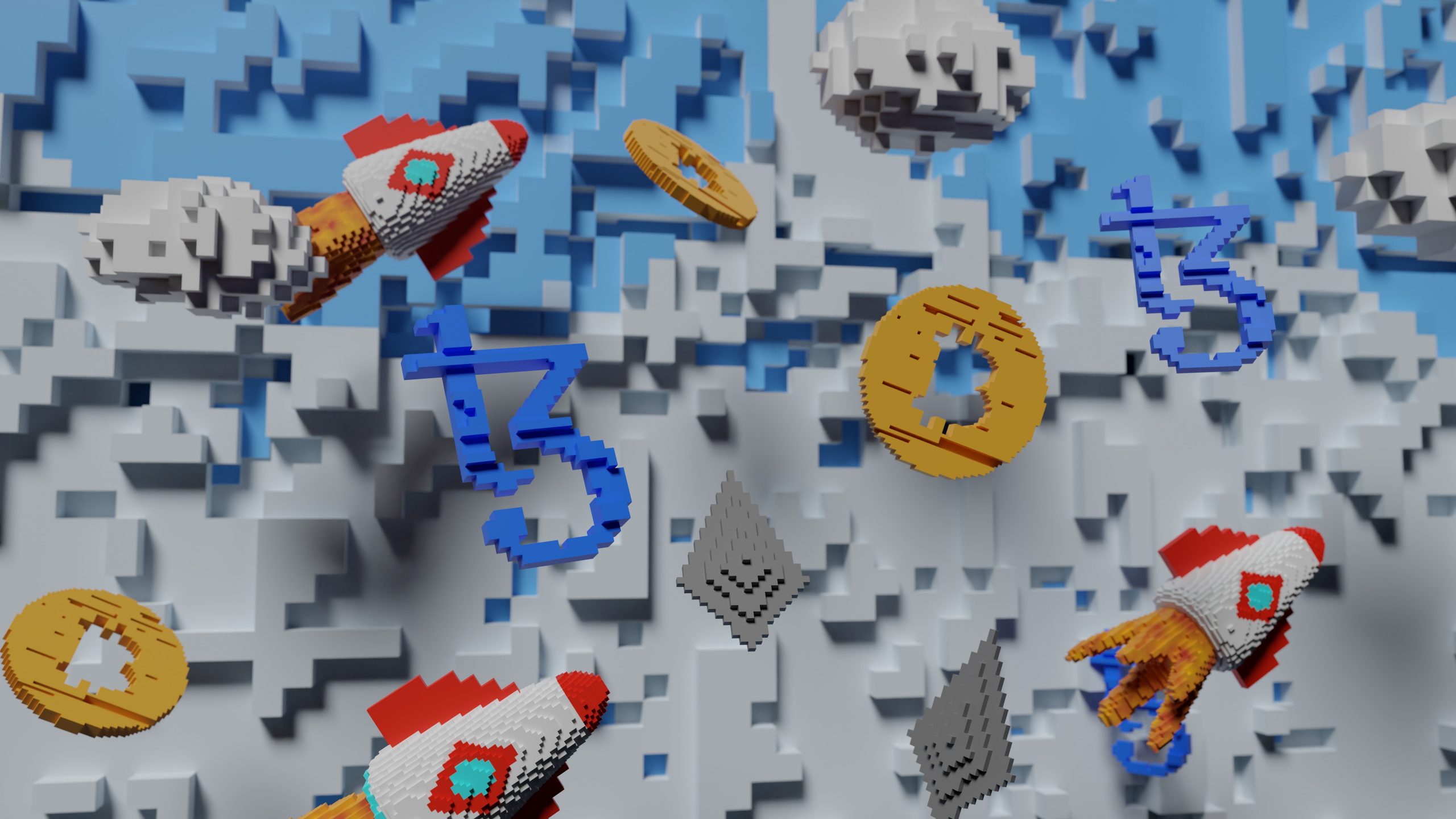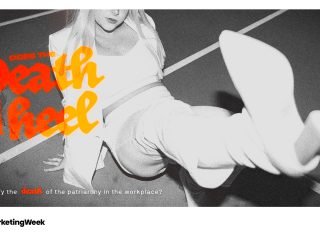Earlier this month we held a Christies-led auction at Mondrian Shoreditch, to sell prints from our International Women’s Day ‘IMAGINE’ campaign. But it was an auction with a twist, as the winning bidders would receive not only the physical art but also each piece’s NFT ‘sister’ version. The evening went brilliantly, we sold every piece within minutes, and seven days on, we’re in the process of gifting the NFTs to their new owners – thus kicking off what we hope will be the beginning of a forever fundraising campaign in aid of our three charity partners, as the blockchain art is exchanged down the months and years to come.
But if this all sounds like we know what we’re talking about, it’s important I stop you there – we do not. Instead, we’re humbly feeling our way, taking advice and inspiration from wherever and whenever we can grab it. I like to think that by pure chance, we’re doing exactly what McKinsey advised in their ‘Value Creation in the Metaverse’ report recently, dipping our toes into the metaverse experience to get a better sense of what it entails, so that we can best understand the full range of opportunities that may be available.
And the truth is after our (very small) ‘IMAGINE an NFT’ experience we can’t help thinking there’s huge potential for purpose-led brands in the web3 space. Why? Because the magic that could happen at the nexus of crypto art, marketing and social impact is incredible. Indeed this was a theme we started to explore during a fireside chat just prior to our auction, with panellists Lavinia Osbourne, founder of Women in Blockchain Talks and NFT marketplace Crypto Kweens; Leah Sams, the illustrator and NFT artist behind Power of Women NFTs; Sophie Conway, client strategist at SmartMedia Labs; Tom Watson, VP of Partnerships at McLaren Automotive, and the lead for the luxury carmaker’s metaverse roadmap and Tina Ziegler, art curator and NFT consultant, and part of the team behind Adidas’ recent, acclaimed digital art exhibition

The advent of web3 and the explosion of the metaverse have created myriad ways in which brands can deepen connections with their customers. As Tom Watson from McLaren put it, “With web3 we want to build something that is authentic, to build a long-term community, engage with that community and learn from them…. From a brand perspective, we’re looking at a goldmine of genuine interactions that help guide decisions as a brand”. This is hot stuff – what marketer doesn’t like the idea of a goldmine – but it’s also all a bit scary for so many of us. Complex language, mystifying terms, and the sense that everyone else knows what they’re talking about and you’ve not been invited to the party (Tip: if that sounds like you, check out Laurence Van Elegem’s brilliant web3 for Dummies explainer, which will inform and entertain in equal measure).
The fact that many feel scared of / alienated from all things web3 currently is a real challenge because exclusion runs counter to two values that sit at the very core of the blockchain-based internet: decentralisation and equality. The sooner we can do away with the daunting terminology and focus instead on the real-life value web3 can deliver, the better. Sophie Conway, whose employer SmartMedia Labs works with brands at the intersection of blockchain, apps and adtech, captured this sentiment perfectly when she commented, “We’ll see the real value in blockchain when we can finally stop naming it a blockchain campaign or activation, it’ll just be a campaign, activation or experience that you can really engage with.”
But while many of us wait for the world of blockchain technology to emerge from the rabbit hole, the good news is that NFTs are a thing – and a buzzy thing with lots of associated FOMO to boot. A fact that makes non-fungible tokens an ideal entry point to ease people into the blockchain space (and yes, we speak from first-hand experience!)

As a creative agency working with brands, it’s reasonable to assume that any point of view we might have on the potential of web3 would be about helping future-focused brands to win in the space and to grow their businesses. And that’s accurate. But perhaps it is our starting point that differentiates us a little: the belief that first and foremost, the blockchain-based internet is a potent enabler of goodness in the world – and that’s a very powerful reality for brands who have Purpose at their core.
At the highest level, NFTs offer a way for brands to engage with their customers in a more interactive and personal way: by creating digital assets that can be collected, traded, and sold, brands can develop huge active communities of fans and collectors around their products and services. But the key here is reciprocity, as Sophie underlined, “Think of a consumer’s engagement now as a currency. That engagement and attention is something that brands want, and people should get something in return for that.” And that’s what the best NFTs, in marketing terms at least, give in return – utility: access to privileges, rights, or rewards that their owners would not otherwise be able to access.
But imagine if part of that utility was also a charitable donation made by the brand to a cause close to its and your heart? And imagine that donation was irreversible, untouchable and that you could track its payout? That’s pretty powerful stuff to a consumer who’s big into NFTs, who wants to see change in the world, and who wants to see brands doubling down on their stated purpose.
The good news is, it’s all possible.

We have music artists to thank for the longstanding notion of royalties, the system that ensures ongoing financial recognition of and reward for that artist’s work. Today royalties for an NFT creator – be it art, music, in-game items or videos – can be written into an NFTs smart contract. In the case of NFT art at least, this blockchain-based royalty system is completely upturning the traditional industry power structure. Art curator and NFT consultant Tina Ziegler is pleasantly surprised by how quickly this is happening, “In the art market, we’ve never had this (system). The artist will sell a piece to a collector, who will sell it to a gallery and they take a large percentage and the artist never sees it again – the original creator doesn’t benefit…. It’s truly revolutionary how NFTs work on the blockchain, and the relationship that the artist can now have directly with their collectors.
”And there’s another benefit: as well as forcing a powershift from gatekeepers to creators, art created and sold via the blockchain also means most intermediaries effectively become redundant – a reality that has a huge positive impact on inclusion and diversity in the space, “The (blockchain) system allows people to dip their toes into the space without the fear of someone saying you’re not welcome here, you don’t earn enough, you don’t look the right way,” says Lavinia Osbourne, founder of Women in Blockchain Talks.

With so much positivity already associated with NFTs and blockchain technology – decentralisation, inclusivity and an end to ravenous powerbrokers – the cherry on the top moment came when someone somewhere along the line figured out that an NFT’s smart contract means it can also be a vehicle for social good as well as personal recompense. The beauty is that this is charitable giving, but not as you know it – “It’s an opportunity to look at philanthropy in a different way” says Leah Sams, the amazing illustrator behind Power of Women NFTs. As well as being a frictionless and feel-good way of giving, fundraising via NFTs can also actively help charities overcome donor apathy, “Too often, unless an issue affects their bubble, people don’t care. But in the NFT space, where it’s about real community, a real sense of people investing in other people, people investing in other creators, there’s a potential for us to really look at donations in very different ways,” adds Sams.
Leah is one example of creators who are intentionally building charitable giving into their art – Power of Women NFTs have to date raised significant funds for a number of causes close to Leah’s heart. But what about brands who see the power of NFTs as part of the marketing mix, but want to ensure that their web3 explorations also support good causes, aligned to their corporate purpose? The daunting prospect of building an NFT art collection with true utility, a robust roadmap, and a thriving community (the three ‘musts’ of most successful NFT drops) is, well, daunting if this is not your natural environment. But there are easier ways into the space, and unsurprisingly they’re all based on finding the right people to collaborate with.

Stella Artois is considered a trailblazer in the space, one of the first brands to drop an NFT collection with all proceeds going to charity, in this case water.org, to help with the global water crisis. Working with Art Blocks and Vayner NFT, the brand was able to raise over $380k in just six hours on World Water Day back in March this year. Kelli Schneider, Crypto Partnerships Associate at The Giving Block – a platform that makes cryptocurrency fundraising easy for nonprofits, and the team Stella turned to, to facilitate the crypto donation to Water.org – advises web2 brands to avoid potential pitfalls and stress by partnering with a dedicated web3 company if they’re looking to move into the web3 space. “Bringing web2 and web3 together can be a great recipe for success because you have the brand recognition and resources of a large well-known company and then you pair that up with a web3 company that knows the space and has years of knowledge in crypto and NFTs.”
Kelli’s advice about the power of partnerships is clearly important – web3 marketing is such a new area for so many, and evolving rapidly. And it will only continue to do so: it’s worth remembering that web3 doesn’t yet actually exist, it is but a utopian place towards which we are all inexorably heading. But it’s also worth recalling McKinsey’s advice, that we should all dip our toes in if we’re to really understand the potential of this utopian place. The point is that sometimes a little exploration on your own is a crucial first step before you bring in the big guys. In our own case with the IMAGINE campaign, it was only thanks to those early baby steps that we came to understand the transformative power blockchain-based art has to create ad-infinitum funding streams for vital causes. And now that we know that, we can’t help thinking about all the incredible good so many brands could do in the world if each and every future brand-led NFT drop had charitable giving at the very top of its roadmap of priorities and commitments.
So, there you have it, we’ve thrown down the gauntlet!




